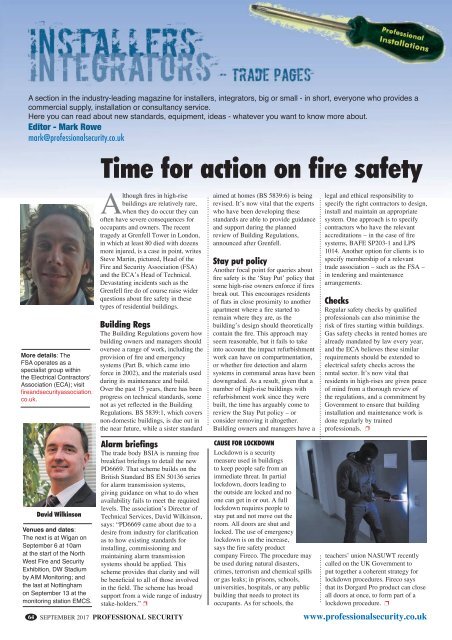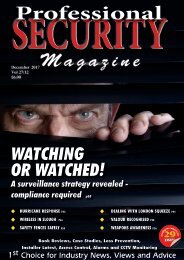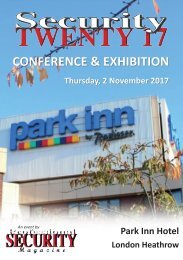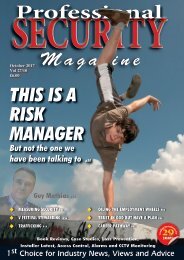You also want an ePaper? Increase the reach of your titles
YUMPU automatically turns print PDFs into web optimized ePapers that Google loves.
A section in the industry-leading magazine for installers, integrators, big or small - in short, everyone who provides a<br />
commercial supply, installation or consultancy service.<br />
Here you can read about new standards, equipment, ideas - whatever you want to know more about.<br />
Editor - Mark Rowe<br />
mark@professionalsecurity.co.uk<br />
Time for action on fire safety<br />
More details: The<br />
FSA operates as a<br />
specialist group within<br />
the Electrical Contractors’<br />
Association (ECA); visit<br />
fireandsecurityassociation.<br />
co.uk.<br />
64<br />
David Wilkinson<br />
Venues and dates:<br />
The next is at Wigan on<br />
September 6 at 10am<br />
at the start of the North<br />
West Fire and Security<br />
Exhibition, DW Stadium<br />
by AIM Monitoring; and<br />
the last at Nottingham<br />
on September 13 at the<br />
monitoring station EMCS.<br />
Although fires in high-rise<br />
buildings are relatively rare,<br />
when they do occur they can<br />
often have severe consequences for<br />
occupants and owners. The recent<br />
tragedy at Grenfell Tower in London,<br />
in which at least 80 died with dozens<br />
more injured, is a case in point, writes<br />
Steve Martin, pictured, Head of the<br />
Fire and Security Association (FSA)<br />
and the ECA’s Head of Technical.<br />
Devastating incidents such as the<br />
Grenfell fire do of course raise wider<br />
questions about fire safety in these<br />
types of residential buildings.<br />
Building Regs<br />
The Building Regulations govern how<br />
building owners and managers should<br />
oversee a range of work, including the<br />
provision of fire and emergency<br />
systems (Part B, which came into<br />
force in 2002), and the materials used<br />
during its maintenance and build.<br />
Over the past 15 years, there has been<br />
progress on technical standards, some<br />
not as yet reflected in the Building<br />
Regulations. BS 5839:1, which covers<br />
non-domestic buildings, is due out in<br />
the near future, while a sister standard<br />
Alarm briefings<br />
The trade body BSIA is running free<br />
breakfast briefings to detail the new<br />
PD6669. That scheme builds on the<br />
British Standard BS EN 50136 series<br />
for alarm transmission systems,<br />
giving guidance on what to do when<br />
availability fails to meet the required<br />
levels. The association’s Director of<br />
Technical Services, David Wilkinson,<br />
says: “PD6669 came about due to a<br />
desire from industry for clarification<br />
as to how existing standards for<br />
installing, commissioning and<br />
maintaining alarm transmission<br />
systems should be applied. This<br />
scheme provides that clarity and will<br />
be beneficial to all of those involved<br />
in the field. The scheme has broad<br />
support from a wide range of industry<br />
stake-holders.” p<br />
SEPTEMBER 2017 PROFESSIONAL SECURITY<br />
aimed at homes (BS 5839:6) is being<br />
revised. It’s now vital that the experts<br />
who have been developing these<br />
standards are able to provide guidance<br />
and support during the planned<br />
review of Building Regulations,<br />
announced after Grenfell.<br />
Stay put policy<br />
Another focal point for queries about<br />
fire safety is the ‘Stay Put’ policy that<br />
some high-rise owners enforce if fires<br />
break out. This encourages residents<br />
of flats in close proximity to another<br />
apartment where a fire started to<br />
remain where they are, as the<br />
building’s design should theoretically<br />
contain the fire. This approach may<br />
seem reasonable, but it fails to take<br />
into account the impact refurbishment<br />
work can have on compartmentation,<br />
or whether fire detection and alarm<br />
systems in communal areas have been<br />
downgraded. As a result, given that a<br />
number of high-rise buildings with<br />
refurbishment work since they were<br />
built, the time has arguably come to<br />
review the Stay Put policy – or<br />
consider removing it altogether.<br />
Building owners and managers have a<br />
CAUSE FOR LOCKDOWN<br />
Lockdown is a security<br />
measure used in buildings<br />
to keep people safe from an<br />
immediate threat. In partial<br />
lockdown, doors leading to<br />
the outside are locked and no<br />
one can get in or out. A full<br />
lockdown requires people to<br />
stay put and not move out the<br />
room. All doors are shut and<br />
locked. The use of emergency<br />
lockdown is on the increase,<br />
says the fire safety product<br />
company Fireco. The procedure may<br />
be used during natural disasters,<br />
crimes, terrorism and chemical spills<br />
or gas leaks; in prisons, schools,<br />
universities, hospitals, or any public<br />
building that needs to protect its<br />
occupants. As for schools, the<br />
legal and ethical responsibility to<br />
specify the right contractors to design,<br />
install and maintain an appropriate<br />
system. One approach is to specify<br />
contractors who have the relevant<br />
accreditations – in the case of fire<br />
systems, BAFE SP203-1 and LPS<br />
1014. Another option for clients is to<br />
specify membership of a relevant<br />
trade association – such as the FSA –<br />
in tendering and maintenance<br />
arrangements.<br />
Checks<br />
Regular safety checks by qualified<br />
professionals can also minimise the<br />
risk of fires starting within buildings.<br />
Gas safety checks in rented homes are<br />
already mandated by law every year,<br />
and the ECA believes these similar<br />
requirements should be extended to<br />
electrical safety checks across the<br />
rental sector. It’s now vital that<br />
residents in high-rises are given peace<br />
of mind from a thorough review of<br />
the regulations, and a commitment by<br />
Government to ensure that building<br />
installation and maintenance work is<br />
done regularly by trained<br />
professionals. p<br />
teachers’ union NASUWT recently<br />
called on the UK Government to<br />
put together a coherent strategy for<br />
lockdown procedures. Fireco says<br />
that its Dorgard Pro product can close<br />
all doors at once, to form part of a<br />
lockdown procedure. p<br />
www.professionalsecurity.co.uk










